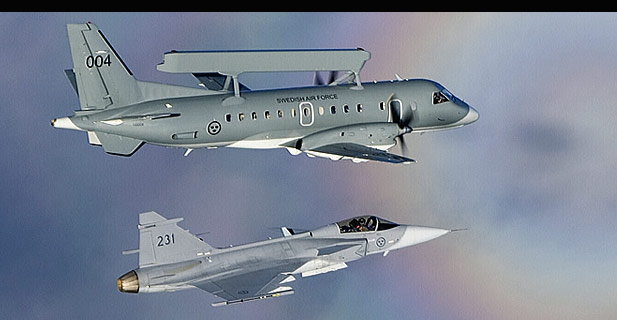
Sweden Finalizes Saab 2000 AEW&C Contract With Pakistan

Saab recently finalized a Skr 8.3 billion (approx. $1.15 billion at then-rate conversion)
provisional contract to supply S100B Argus turboprop airborne early warning (AEW&C) systems to Pakistan. According to earlier reports at Pakistani Defence , Pakistan will acquire 14 SAAB 2000 aircraft from Sweden: 7 of these aircraft will be dedicated for the PAF's AEW&C role as Argus aircraft, while the remaining 7 will be acquired by the PIA airline to replace its fleet of 11 aging and largely-grounded Fokker short-haul turboprop aircraft [DID note: the mix now looks like 6 and 6].
The Saab aircraft beat a number of other competitors, including Bombardier's Dash-8/Q200 and US offers to sell the E-2C Hawkeye system. The Argus AEW&C award also caps a 25-year quest by the Pakistani Air force - but the buy was recently reduced for financial reasons....
In "SAAB 2000 & ERIEYE AWE&C system,"a Pakistani government site explains the operational need for these aircraft, and chronicles their pursuit of the 707-based E-3C AWACS aircraft and related systems since 1979. Indeed, Pakistan had pursued the Erieye system before, but had been rejected several times under Sweden's military export policies. With that roadblock clear, Pakistan has engaged in long negotiations with Saab that have finally come to fruition. With respect to the new aircraft's radar capabilities, the article notes that:
"The Ericsson PS-890 Erieye radar uses an active array with 200 solid state modules. The range of the S-band, 3 GHz, and side looking radar is 300 km. The 1,985-lb (900-kg) dorsal antenna is housed in a 29-ft 6.3-in (9-m) long box radome mounted atop the fuselage. Utilizing adaptive side lobe suppression, the look angle on each side is about 160 degrees. From its standard operational altitude of 6000 metres (19,685 feet, or FL200) the radar has a maximum range of 450 km (279 miles). Against a fighter-sized target effective range is approximately 330 km (205 miles). Seaborne targets can be detected at 320 km (1998 miles), though this is a function of the aircraft's cruising height. The electronically scanned antenna can scan sectors of interest frequently while others are monitored, and a single sector can be scanned in different modes at the same time."
That last bit is a reference to the AESA radar's ability to scan ground and air activity at the same time, rather than switching between these modes as conventional radars do. An Australian airpower article explains the potential benefits of AESA radars against other AEW&C offerings like the E-2C Hawkeye - and also notes the limitations of the S100B/Erieye system:
"The limitation of the two sided array is that it can only cover two 120 degree sectors abeam of the aircraft, leaving 60 degree blind sectors over the nose and tail of the aircraft, and reduced antenna performance from 45 degrees off the beam aspect. Another limitation stems from the use of an airframe too small to accommodate a comprehensive self contained command, control and communications system, and other sensors such as a capable ESM and track association system."
Saab's corporate release notes that "two third of the order value is for Saab and one third for Ericsson Microwave Systems [for the PS-890 Erieye radars], witch is, after the Saab acquisition, expected to be a part of Saab in September 2006." DID recently covered that acquisition.
(This article originally ran June 26, 2006)
UPDATES:
May 28/07: Maybe not quite finalized. A Saab release states that:
"With reference to the sale of Saab Airborne Surveillance Systems to Pakistan, the customer has for financial reasons and in accordance with the original contract, asked to renegotiate part of the contract concerning a reduction of the number of systems. Together with Saab terms and conditions then have been agreed, concerning a reduction. Saab and the Government of Pakistan continue as planned with the delivery of the system.
As a result of the renegotiation, the order value is decreased by approximately SEK 1.35 billion [DID 8.3B - 1.35B = 6.95B, a 16.3% reduction and about $1 billion at a May 28 conversion]. Income will decrease proportionally to the volume change, but other commercial terms and conditions will remain unchanged."
While the number of planes in the revised order was not specified, the reduction amount suggests that the contract now covers 6 AEW&C aircraft, and 6 transports.
Source: Defense Industry Daily
(www.defenseindustrydaily.com)
Posted : May 30, 2007
Photo : S-1000 & Gripen.
[Defense Industry Daily photo]
(31.05.2007)
|